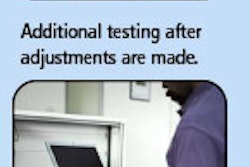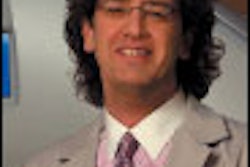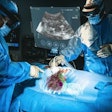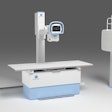More momentum appears to be swinging toward 3-tesla MR magnets as an increasingly useful tool in a myriad of clinical applications. What may stymie the euphoria of having a new resource to serve patients -- at least at standalone imaging centers -- is reduced Medicare reimbursements triggered by the Deficit Reduction Act (DRA) of 2005.
Dr. Suresh K. Mukherji, director of neuroradiology at the University of Michigan (UM) in Ann Arbor, is among clinicians who see a tremendous upside to 3-tesla MRI. With its increased signal-to-noise ratio, Mukherji believes that MR angiography images are "fantastic," and niche applications, such as functional MRI and spectroscopy, are performed faster with more than adequate resolution. All of UM's carotid imaging is handled on a 3-tesla scanner.
"Especially for the brain applications, you can do everything on a 3T MRI that you can do on a 1.5T," he said.
UM performs approximately 20,000 MR scans annually on one 3-tesla MRI system and five 1.5-tesla magnets. Like other facilities, UM balances the need for enhanced patient throughput -- which 3-tesla provides with shorter scan times -- with image quality. "Do you want to push more patients through and make the 3T images look more like 1.5T images? Or do you want to take advantage of the spatial resolution?" Mukherji queried. "We try to do both."
Outpatient lumbar spine images, for example, are completed on the 3-tesla system relatively quickly in three sequences. "With the brain, we won't 'dumb down' the images, so they look like a 1.5T," he said. "On the other hand, we are not going to maximize resolution, so we try to get a little of both. We have to be cognizant of throughput."
Speed versus image quality
Of course, the primary concern is how well served patients are with 3-tesla MRI. Dr. Mitchell Schnall, vice chair for research in the department of radiology at the University of Pennsylvania in Philadelphia, said the answer isn't necessarily an obvious one. "Say I am imaging a brain. Just because I can make a better image and see the anatomy better, will I find diseases (and) characterize diseases better than I did before? There is some data out there, but it does not answer the question effectively."
"When you are imaging small structures, (3 tesla) can benefit quite a bit with the musculoskeletal system, particularly small joints, such as wrists and ankles."
-- Dr. Mitchell Schnall, University of Pennsylvania, Philadelphia
Ultimately, every time a clinician pushes speed, he or she is also pushing resolution, so there must be a balance to meet a certain resolution requirement. "When you are imaging small structures, it can benefit quite a bit with the musculoskeletal system, particularly small joints, such as wrists and ankles," Schnall said. In breast imaging, 3-tesla MRI helps Schnall heighten spatial resolution to approximately 0.2 mm.
MRI evolution
"If … you believe that 3T is the new premier field strength in MR -- which I do -- then you don't want to buy another 1.5T, because you will be stuck with it for 10 years."
-- Dr. Val Runge, Scott & White Hospital and Clinic, Temple, TX
Still, there are noticeable differences. "Any imaging that has to do with the brain is markedly superior (with 3 tesla), and the majority of cervical spines are marginally superior," Runge noted. "In terms of the thoracic spine and lumbar spine, some radiologists prefer the 1.5T to the 3T."
Spatial resolution takes precedence over speed in procedures, such as contrast-enhanced MR angiography and carotid imaging, which visualizes carotid bifurcation arteriosclerotic disease. "That is currently done as a 20-second breath-hold scan with intravenous gadolinium administration," Runge said. "On the 3T, we use the entire 20 seconds and go for increased spatial resolution."
Thinner slices
3-tesla scanning has also greatly enhanced spatial resolution compared to older MRI technology. For example, a head scan with a 0.3-tesla or 0.6-tesla scanner provides sections of 10-mm thickness. A 1-tesla MRI reduces the thickness to 7 mm, and a 1.5-tesla system thins the sections even further to 5 mm. With 3-tesla, Runge is acquiring sections of the head between 3 mm and 4 mm in thickness, and acquires them in less time than the 1.5-tesla system.
"We feel we can do recognizably better work in typically one-third less time with greater consistency exam to exam." -- Dr. Lawrence Tanenbaum, Edison Imaging Associates, Edison, NJ
"We feel we can do recognizably better work in typically one-third less time with greater consistency exam to exam," he added. "The consistency is due, at least in part, to protocols designed with surplus signal-to-noise."
By personal choice or because of the lower Medicare reimbursements from the DRA, some imaging facilities choose to use their 3-tesla MRI scans in 20-minute slots to increase patient throughput. "I don't think you will deliver the same image quality you could on a 3T doing 20-minute slots," Tanenbaum said, "but you should have no problem in 20 minutes, doing better work than you could on a 1.5T in a 30-minute exam."
Tanenbaum considers neurovascular imaging as one exam that should always be conducted at 3 tesla. Many of Edison's referring orthopedic surgeons are "absolutely insistent," Tanenbaum said, that 3-tesla be used for their exams, because they have seen the boost in image quality.
Neuroskeletal Imaging of Winter Park, FL, handles 30 to 35 patients per day on its 3-tesla MRI, predominantly performing neuro and musculoskeletal scans. The imaging center also performs spectroscopy, brain tumor imaging, and some functional imaging with its 3-tesla scanner.
Given the choice between greater patient throughput and image quality, Dr. Marc Shapiro, chief of neuroradiology and president of the center, always opts for better images, using ultrathin sections. Brains, for example, are imaged with 1 mm to 3 mm sections.
3T economics 101
As already mentioned, it is impossible to discuss 3-tesla MRI without the issue of reduced Medicare reimbursement, due to the DRA, which reduced Medicare reimbursement for outpatient imaging procedures as of January 1. Most adversely affected are imaging centers, which now are paid less for 3-tesla MRI scans. "My one concern about 3T is reimbursement going down," Shapiro said. "That is the only thing that will stop 3T from replacing 1.5T as a clinical tool -- and it is a major thing."
Shapiro, who has worked with 3-tesla MRI since 2003, estimates the initial cost of the best 3-tesla system is approximately 30% higher than the best 1.5-tesla MRI. But a DRA-related slowdown on overall equipment purchasing could actually work in 3-tesla MRI's favor if imaging facilities decide that they need to maximize their investment once they've decided they can no longer avoid upgrading their technology.
Given that more facilities are opting for 3-tesla scanning and committing to the greater investment, Scott & White's Runge believes the six- to eight-year replacement cycle of an MRI system will increase. "If that is true and you believe that 3T is the new premier field strength in MR -- which I do -- then you don't want to buy another 1.5T, because you will be stuck with it for 10 years."
By Wayne Forrest
AuntMinnie.com staff writer
March 1, 2007
Copyright © 2007 AuntMinnie.com



















